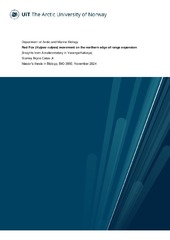| dc.description.abstract | Red foxes (Vulpes vulpes) are expanding into Arctic regions, altering predator-prey dynamics and intensifying competition with native species such as the Arctic fox (Vulpes lagopus). This study examines the activity patterns of red foxes in Varanger, Norway, at the forefront of their Arctic range expansion, focusing on the effects of environmental factors (e.g., snow depth, temperature, precipitation) and human influence on their behavior. Using GPS and accelerometry data (Overall Dynamic Body Acceleration, ODBA), integrated with environmental variables, we analyzed red fox activity across 1,085 fox-days from four individuals.
Results revealed that snow presence significantly reduced overall daily activity but did not affect the proportion of time spent active, indicating behavioral adjustments to energy conservation during winter. Vegetation biomass consistently correlated with increased activity, highlighting its role as both a resource and a sheltering habitat. Human land-use intensity influenced activity patterns, with foxes exhibiting reduced activity near human infrastructure during snow-free periods but increased presence in these areas during winter, likely due to resource availability.
These findings underscore the complex interplay between environmental factors and anthropogenic influences in shaping red fox behavior. The results also have implications for conservation management, suggesting that targeted vegetation control and reductions in human-mediated food subsidies could mitigate the red fox's impact on Arctic ecosystems. By improving our understanding of red fox behavioral adaptations, this study contributes to broader efforts to balance species management and ecosystem conservation in dynamic, climate-affected landscapes. | en_US |


 English
English norsk
norsk
